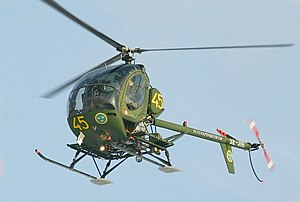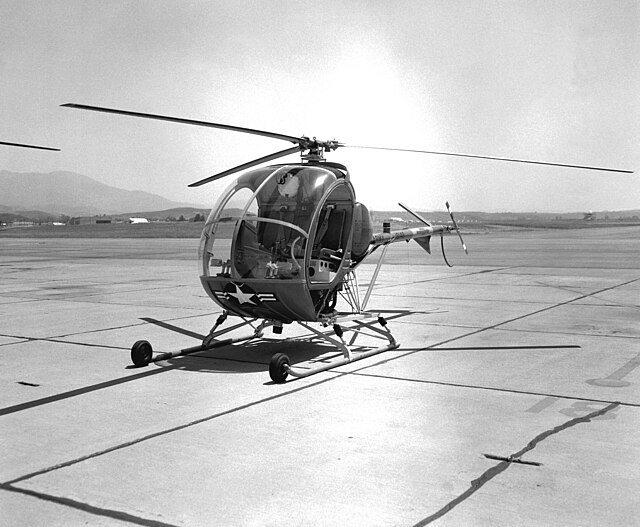Piston-powered light training helicopter produced for the United States Army From Wikipedia, the free encyclopedia
The Hughes TH-55 Osage is a piston-powered light training helicopter produced for the United States Army. It was also produced as the Model 269 family of light utility helicopters, some of which were marketed as the Model 300. The Model 300C was produced and further developed by Schweizer after 1983.
| TH-55 Osage Hughes 269 | |
|---|---|
 A Schweizer 300C with the Swedish Air Force Museum | |
| General information | |
| Type | Light utility and trainer helicopter |
| Manufacturer | Hughes Helicopters |
| Primary user | United States Army |
| Number built | 2,800[1] |
| History | |
| Manufactured | 1961–1983 |
| First flight | 2 October 1956 |
| Variants | Schweizer S300 |
In 1955, Hughes Tool Company's Aircraft Division carried out a market survey which showed that there was a demand for a low-cost, lightweight two-seat helicopter. The division began building the Model 269 in September 1955. It was initially designed with a fully glazed cockpit with seating for two pilots, or a pilot and passenger. It also had an open-framework fuselage and a three-blade articulated rotor. The prototype flew on 2 October 1956,[2] but it wasn't until 1960 that the decision was made to develop the helicopter for production. The original truss-work tailboom was replaced with a tubular tailboom and the cockpit was restructured and refined prior to being put into production, resulting in the Model 269A. With this model, Hughes successfully captured a large portion of the civilian helicopter market[2] with an aircraft that would prove itself popular in agriculture, police work and other duties.
The Hughes 269 was designed with a fully articulated, three-blade main rotor designed by Drago Jovanovich, and a two-blade tail rotor that would remain as distinctive characteristics of all its variants. It also has shock absorber-damped, skid-type landing gear. The flight controls are directly linked to the swashplate of the helicopter so there are no hydraulic systems in the 269. There are generally two sets of controls, although this was optional on the civil 269A. For three-seat aircraft, the middle collective control stick is removable and a seat cushion can be put in its place for the third passenger.

In 1958, prior to full-time production, Hughes provided five preproduction Model 269A examples to the U.S. Army for evaluation as a light observation helicopter to replace the aging OH-13 Sioux and OH-23 Raven. Designated as the YHO-2HU[3][4] the helicopter was eventually turned down. On 9 April 1959, the 269A received certification from the FAA. Hughes continued to concentrate on civil production, and deliveries of the Model 269A began in 1961. By mid-1963 about 20 aircraft were being produced a month and by the spring of 1964, 314 had been built.
While the U.S. Army had not found the Model 269A adequate for combat missions, in 1964 it adopted a modified version of the 269A as its training helicopter to replace the TH-23 and designated it the TH-55A Osage.[4] 792 TH-55 helicopters would be delivered by 1969, and it would remain in service as the U.S. Army's primary helicopter trainer until it was replaced in 1988 by the UH-1 Huey. At the time of its replacement, over 60,000 U.S. Army pilots had trained on TH-55 making it the U.S. Army's longest serving training helicopter.[3] In addition to the U.S. Army, Hughes delivered TH-55/269/300s to other military customers.[3]
In 1964, Hughes introduced the slightly larger three-seat Model 269B which it marketed as the Hughes 300. That same year, the Hughes 269 set an endurance record of 101 hours. To set the record, two pilots took turns piloting the aircraft and hovered in ground-effect for fueling. To ensure no cheating, eggs were attached to the bottom of the skid gear to register any record-ending landing.[2]

The Hughes 300 was followed in 1969 by the improved Hughes 300C (sometimes 269C), which first flew on 6 March 1969 and received FAA certification in May 1970. This new model introduced a more powerful 190 hp (140 kW) Lycoming HIO-360-D1A engine and an increased-diameter rotor, giving a payload increase of 45%, plus overall performance improvements.[3] It was this model that Schweizer began building under license from Hughes in 1983.[5] In 1986, Schweizer acquired all rights to the helicopter from McDonnell Douglas, who had purchased Hughes Helicopters in 1984, and renamed it McDonnell Douglas Helicopter Systems. For a few years after, Schweizer acquired the FAA Type Certificate known as the Schweizer-Hughes 300. While Schweizer made over 250 minor improvements, the basic design remained unchanged.
Between Hughes and Schweizer, and including foreign-licensed production civil and military training aircraft, nearly 3,000 copies of the Model 269/300 have been built and flown over the last 50 years. That would have been the end of the story, but Schweizer continued to develop the model 300 by adding a turbine and redesigning the body to create the model 330m, and then further developed the dynamic components to take greater advantage of the power of the turbine engine; this led to the development of the Model 333.



Data from Jane's All the World's Aircraft 1974-75[34] Evergreen Aviation and Space Museum[2]
General characteristics
Performance
Related development
Aircraft of comparable role, configuration, and era
Related lists
Seamless Wikipedia browsing. On steroids.